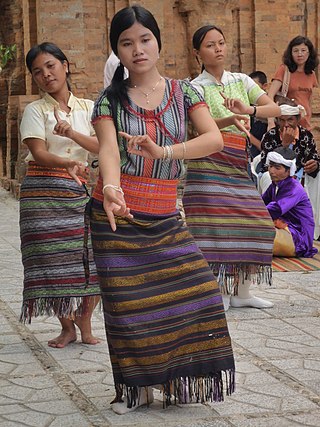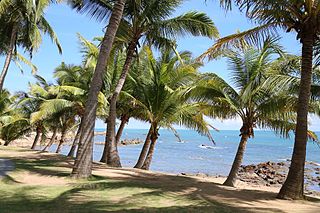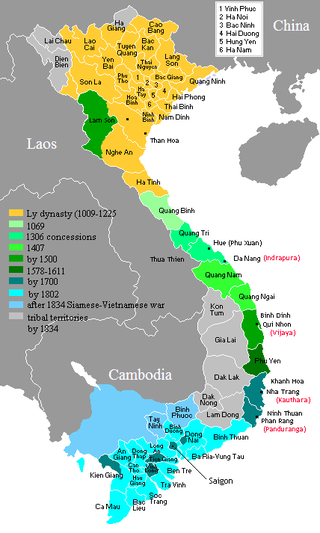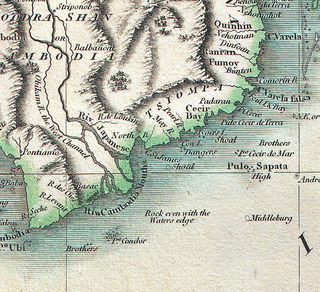
The Austroasiatic languages, are a large language family in Mainland Southeast Asia, South Asia and East Asia. These languages are scattered throughout parts of Thailand, Laos, India, Myanmar, Malaysia, Bangladesh, Nepal, and southern China. Austroasiatic constitute the majority languages of Vietnam and Cambodia. There are around 117 million speakers of Austroasiatic languages, of which more than two-thirds are Vietnamese speakers. Of these languages, only Vietnamese, Khmer, and Mon have a long-established recorded history. Only two have official status as modern national languages: Vietnamese in Vietnam and Khmer in Cambodia. The Mon language is a recognized indigenous language in Myanmar and Thailand. In Myanmar, the Wa language is the de facto official language of Wa State. Santali is one of the 22 scheduled languages of India. The rest of the languages are spoken by minority groups and have no official status.

The Hlai, also known as Li or Lizu, are a Kra–Dai-speaking ethnic group, one of the 56 ethnic groups officially recognized by the People's Republic of China. The vast majority live off the southern coast of China on Hainan Island, where they are the largest minority ethnic group. Divided into the five branches of the Qi (Gei), Ha, Run (Zwn), Sai and Meifu (Moifau), the Hlai have their own distinctive culture and customs.

The Chams or Champa people are an Austronesian ethnic group in Southeast Asia, and indigenous people of Central Vietnam.

Champa was a collection of independent Cham polities that extended across the coast of what is present-day central and southern Vietnam from approximately the 2nd century AD until 1832, when the last remaining principality of Champa was annexed by the Vietnamese Nguyễn dynasty under its emperor Minh Mạng as part of its expansionist Nam tiến policy. The kingdom was known variously as Nagaracampa, Champa (ꨌꩌꨛꨩ) in modern Cham, and Châmpa (ចាម្ប៉ា) in the Khmer inscriptions, Chiêm Thành in Vietnamese and Zhànchéng in Chinese records.

Hainan is the smallest and southernmost province of the People's Republic of China (PRC), consisting of various islands in the South China Sea. Hainan Island, the largest and most populous island in China, makes up the vast majority (97%) of the province. The name means "south of the sea", reflecting the island's position south of the Qiongzhou Strait, which separates it from Leizhou Peninsula and the Chinese mainland.
Tsat, also known as Utsat, Utset, Hainan Cham, or Huíhuī, is a tonal language spoken by 4,500 Utsul people in Yanglan (羊栏) and Huixin (回新) villages near Sanya, Hainan, China. Tsat is a member of the Malayo-Polynesian group within the Austronesian language family, and is one of the Chamic languages originating on the coast of present-day Vietnam.

Cham is a Malayo-Polynesian language of the Austronesian family, spoken by the Chams of Southeast Asia. It is spoken primarily in the territory of the former Kingdom of Champa, which spanned modern Southern Vietnam, as well as in Cambodia by a significant population which descends from refugees that fled during the decline and fall of Champa. The Western variety is spoken by 220,000 people in Cambodia and 25,000 people in Vietnam. As for the Eastern variety, there are about 73,000 speakers in Vietnam, for a total of approximately 320,000 speakers.

Islam in Vietnam is primarily the religion of the Cham people, an Austronesian minority ethnic group; however, roughly one-third of Muslims in Vietnam are of other ethnic groups. There is also a community, which describes itself as of mixed ethnic origins, that practices Islam and is also known as the Cham, or Cham Muslims, around the region of Châu Đốc in the Southwest.

The largest of the ethnic groups in Cambodia are the Khmer, who comprise approximately 90% of the total population and primarily inhabit the lowland Mekong subregion and the central plains. The Khmer historically have lived near the lower Mekong River in a contiguous arc that runs from the southern Khorat Plateau where modern-day Thailand, Laos and Cambodia meet in the northeast, stretching southwest through the lands surrounding Tonle Sap lake to the Cardamom Mountains, then continues back southeast to the mouth of the Mekong River in southeastern Vietnam.

The earliest anatomically modern human skeleton in Peninsular Malaysia, Perak Man, dates back 11,000 years and Perak Woman dating back 8,000 years, were both discovered in Lenggong. The site has an undisturbed stone tool production area, created using equipment such as anvils and hammer stones. The Tambun rock art is also situated in Perak. From East Malaysia, Sarawak's Niah Caves, there is evidence of the oldest human remains in Malaysia, dating back 40,000 years.
The Chamic languages, also known as Aceh–Chamic and Achinese–Chamic, are a group of ten languages spoken in Aceh and in parts of Cambodia, Thailand, Vietnam and Hainan, China. The Chamic languages are a subgroup of Malayo-Polynesian languages in the Austronesian family. The ancestor of this subfamily, proto-Chamic, is associated with the Sa Huỳnh culture, its speakers arriving in what is now Vietnam from Formosa.
Jiamao is a divergent Kra-Dai language or possible language isolate spoken in southern Hainan, China. Jiamao speakers' autonym is 1.
The Hlai languages are a primary branch of the Kra–Dai language family spoken in the mountains of central and south-central Hainan in China by the Hlai people, not to be confused with the colloquial name for the Leizhou branch of Min Chinese. They include Cun, whose speakers are ethnically distinct. A quarter of Hlai speakers are monolingual. None of the Hlai languages had a writing system until the 1950s, when the Latin script was adopted for Ha.

Nam tiến is a historiographical concept that describes the historic southward expansion of the territory of Vietnamese dynasties' dominions of Đại Việt from the 11th to the 19th centuries. The concept of Nam tiến has differing interpretations, with some equating it to Viet colonialism of the south and to a series of wars and conflicts between several Vietnamese kingdoms and Champa Kingdoms, which resulted in the annexation and Vietnamization of the former Cham states as well as indigenous territories.
The history of Champa begins in prehistory with the migration of the ancestors of the Cham people to mainland Southeast Asia and the founding of their Indianized maritime kingdom based in what is now central Vietnam in the early centuries AD, and ends when the final vestiges of the kingdom were annexed and absorbed by Vietnam in 1832.

Panduranga or Prangdarang was a Cham Principality and later, the rump state successor of the Champa kingdom, which was destroyed by Vietnamese emperor Le Thanh Tong in 1471. It was located in present-day Southcentral Vietnam. It stood until late 17th century as the Nguyễn lords of Đàng Trong, a powerful Vietnamese clan, vassalized it and put the Cham polity under the name Principality of Thuận Thành.
Lưu Kế Tông or Lưu Kỳ Tông (?–989), was the king of Champa from 986 to 989.
Peter K. Norquest is an American linguist who specializes in Kra–Dai historical linguistics.












